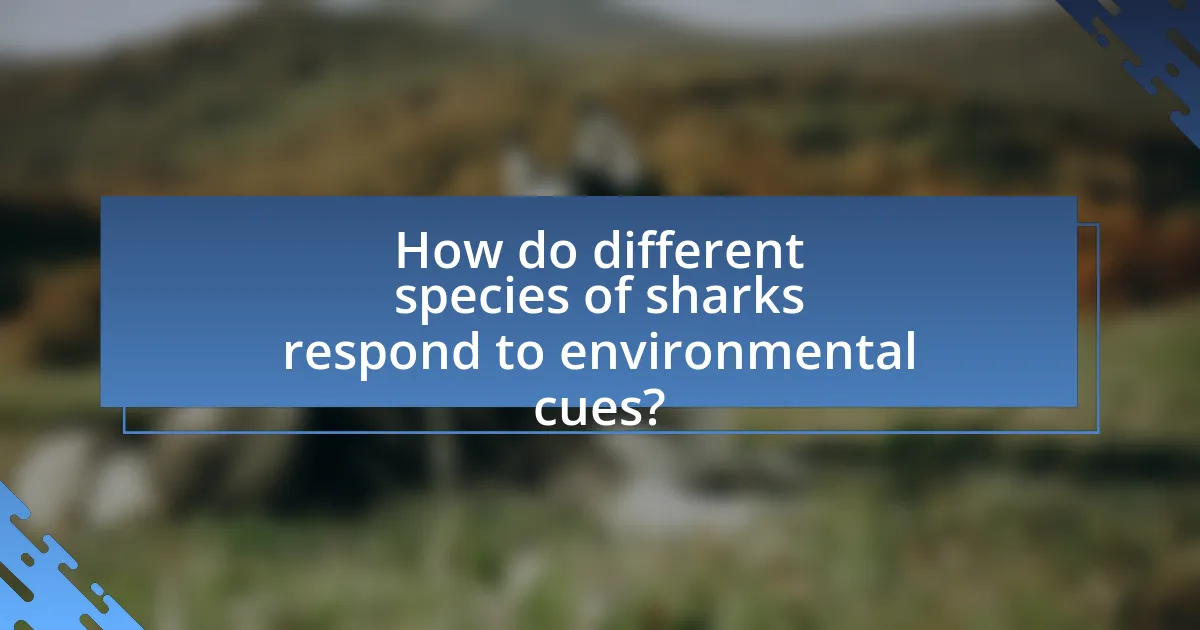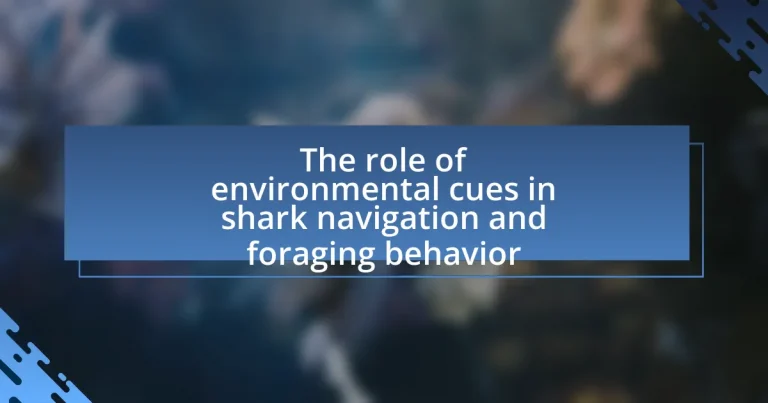Environmental cues play a crucial role in shark navigation and foraging behavior, serving as sensory signals that guide sharks in locating prey and suitable habitats. These cues encompass chemical signals, such as pheromones and amino acids, as well as physical factors like water temperature, salinity, and ocean currents. Sharks utilize their acute sensory systems, including olfactory capabilities and electroreception, to interpret these environmental signals, which significantly influence their migratory patterns and foraging strategies. Understanding how different shark species respond to these cues can inform conservation efforts and sustainable fishing practices, ultimately aiding in the protection of shark populations and their habitats.

What are environmental cues and their significance in shark navigation and foraging behavior?
Environmental cues are sensory signals from the environment that sharks utilize for navigation and foraging. These cues include chemical signals, such as pheromones and amino acids, as well as physical cues like water temperature, salinity, and ocean currents. The significance of these cues lies in their ability to guide sharks to prey and suitable habitats, enhancing their foraging efficiency and survival. For instance, studies have shown that sharks can detect prey from significant distances by sensing chemical cues released into the water, allowing them to locate food sources effectively. Additionally, environmental cues help sharks navigate vast oceanic distances, as they can use variations in water temperature and salinity to orient themselves and migrate.
How do sharks utilize environmental cues for navigation?
Sharks utilize environmental cues for navigation primarily through their acute sensory systems, including the detection of electromagnetic fields, water temperature gradients, and chemical signals. These sensory adaptations allow sharks to interpret their surroundings effectively; for instance, they can sense the Earth’s magnetic field, which aids in long-distance migration. Research indicates that species like the great white shark can detect minute changes in the magnetic field, enabling them to navigate across vast oceanic distances with precision. Additionally, sharks use olfactory cues to locate prey and navigate towards specific habitats, demonstrating their reliance on a combination of environmental signals for successful navigation and foraging.
What types of environmental cues do sharks rely on for navigation?
Sharks rely on several types of environmental cues for navigation, including olfactory signals, electroreception, and visual cues. Olfactory signals allow sharks to detect chemical gradients in the water, helping them locate prey and navigate through their environment. Electroreception enables sharks to sense the electric fields generated by other organisms, which is crucial for locating prey hidden in the substrate. Additionally, visual cues assist sharks in recognizing landmarks and navigating through their habitats. These navigation methods are supported by research indicating that sharks can detect scents from miles away and have specialized organs, such as the ampullae of Lorenzini, for electroreception.
How do these cues influence shark migratory patterns?
Environmental cues significantly influence shark migratory patterns by guiding their movements in response to changes in temperature, salinity, and prey availability. Sharks utilize these cues to navigate across vast oceanic distances, often migrating to areas that provide optimal conditions for feeding and breeding. For instance, studies have shown that temperature gradients can trigger seasonal migrations, as sharks seek warmer waters during colder months, enhancing their foraging efficiency. Additionally, the presence of specific prey species can attract sharks to particular regions, further shaping their migratory routes. Research indicates that these environmental factors are critical for the survival and reproductive success of various shark species, demonstrating the intricate relationship between sharks and their habitats.
What role do environmental cues play in shark foraging behavior?
Environmental cues significantly influence shark foraging behavior by guiding their hunting strategies and prey detection. Sharks utilize various sensory modalities, including olfaction, electroreception, and vision, to interpret environmental signals such as water temperature, salinity, and the presence of prey. For instance, studies have shown that sharks can detect chemical cues released by injured prey from considerable distances, allowing them to locate food sources effectively. Additionally, changes in water temperature can indicate the migration patterns of prey species, further aiding sharks in optimizing their foraging efforts.
How do sharks detect prey using environmental cues?
Sharks detect prey using environmental cues primarily through their acute sense of smell and specialized sensory organs called ampullae of Lorenzini. These organs allow sharks to sense electrical fields generated by the movements of prey, as well as changes in water pressure and temperature. Research indicates that sharks can detect blood in the water from over a mile away, showcasing their remarkable olfactory capabilities. Additionally, they utilize visual cues and the sounds produced by prey to enhance their foraging efficiency, making them highly effective predators in various marine environments.
What specific environmental factors enhance foraging success in sharks?
Specific environmental factors that enhance foraging success in sharks include water temperature, salinity, and the presence of prey. Water temperature influences metabolic rates and hunting efficiency; for example, many shark species are more active and successful in warmer waters, which can increase prey availability. Salinity affects the distribution of prey species, as certain fish and marine organisms thrive in specific salinity ranges, thus impacting shark foraging patterns. Additionally, the presence of prey, often indicated by environmental cues such as changes in water color or the presence of other marine life, directly correlates with foraging success, as sharks are more likely to hunt in areas where prey is abundant.

How do different species of sharks respond to environmental cues?
Different species of sharks respond to environmental cues through a combination of sensory adaptations that enhance their navigation and foraging behaviors. For instance, species like the great white shark utilize electroreception to detect the electric fields generated by prey, while others, such as the hammerhead shark, have a highly developed sense of smell that allows them to locate food from great distances. Research indicates that sharks can also respond to changes in water temperature, salinity, and pressure, which help them navigate and find suitable habitats. A study by Kajiura and Holland (2002) demonstrated that blacktip reef sharks alter their foraging strategies based on the availability of prey and environmental conditions, showcasing the adaptability of their behavior in response to specific cues.
What variations exist in cue utilization among shark species?
Variations in cue utilization among shark species include differences in reliance on chemical, visual, and acoustic cues for navigation and foraging. For instance, species like the great white shark primarily utilize olfactory cues to detect prey from long distances, while hammerhead sharks exhibit enhanced visual capabilities, allowing them to better navigate complex environments. Additionally, some species, such as the nurse shark, rely heavily on electroreception to locate prey hidden in the substrate. Research indicates that these differences are influenced by ecological niches and evolutionary adaptations, with studies showing that species in open waters may prioritize different cues compared to those in coastal or reef environments.
How do habitat preferences affect cue reliance in different shark species?
Habitat preferences significantly influence cue reliance in different shark species by determining the types of environmental signals they prioritize for navigation and foraging. For instance, species like the tiger shark, which inhabit diverse environments including coastal areas and open ocean, rely on a combination of chemical cues and visual signals to locate prey. In contrast, species such as the nurse shark, which prefer shallow, reef-associated habitats, depend more heavily on tactile and olfactory cues due to their proximity to the ocean floor and the structure of their environment. Research indicates that these preferences shape the sensory modalities sharks utilize; for example, a study by Hueter et al. (2004) found that habitat complexity directly affects the reliance on specific cues, with more complex habitats leading to increased use of olfactory cues among species that dwell in such environments. Thus, habitat preferences dictate the sensory strategies sharks employ, reflecting their adaptation to specific ecological niches.
What adaptations have evolved in sharks for better navigation and foraging?
Sharks have evolved several adaptations for better navigation and foraging, including the development of specialized sensory organs, such as the ampullae of Lorenzini, which detect electrical fields generated by prey. These sensory adaptations allow sharks to locate prey even in murky waters or at great depths. Additionally, sharks possess a keen sense of smell, capable of detecting blood and other chemical cues from significant distances, enhancing their foraging efficiency. Their lateral line system, which senses vibrations and pressure changes in the water, further aids in navigation and locating prey. These adaptations collectively enable sharks to thrive in diverse marine environments and effectively hunt for food.
How do environmental changes impact shark behavior?
Environmental changes significantly impact shark behavior by altering their navigation and foraging patterns. For instance, shifts in water temperature can influence the distribution of prey species, prompting sharks to migrate to new areas in search of food. Research indicates that sharks are sensitive to changes in salinity and temperature, which can affect their hunting efficiency and reproductive behaviors. A study published in the journal “Marine Ecology Progress Series” found that increased ocean temperatures led to changes in the migratory routes of several shark species, demonstrating a direct link between environmental conditions and behavioral adaptations.
What effects do climate change and habitat degradation have on shark navigation?
Climate change and habitat degradation disrupt shark navigation by altering environmental cues essential for their migratory patterns. Sharks rely on various sensory inputs, including temperature gradients, salinity levels, and magnetic fields, to navigate effectively. Changes in ocean temperature due to climate change can affect these cues, leading to disorientation and altered migratory routes. For instance, research indicates that rising sea temperatures can shift the distribution of prey species, forcing sharks to adapt their navigation strategies. Additionally, habitat degradation, such as coral reef destruction, diminishes the structural complexity of environments that sharks use for navigation, further complicating their ability to find food and mates. These disruptions can ultimately impact shark populations and their ecological roles in marine ecosystems.
How do shifts in prey availability influence shark foraging strategies?
Shifts in prey availability significantly influence shark foraging strategies by prompting sharks to adapt their hunting behaviors and locations. When prey populations decline or shift due to environmental changes, sharks may alter their foraging areas, increase their search time, or modify their hunting techniques to optimize energy expenditure and maximize feeding success. For instance, research has shown that when certain fish species become less abundant, sharks may switch to alternative prey, demonstrating flexibility in their dietary habits. This adaptability is crucial for their survival, as evidenced by studies indicating that sharks can track prey movements and adjust their foraging patterns accordingly, ensuring they remain efficient predators in varying ecological conditions.

What are the implications of understanding shark navigation and foraging behavior?
Understanding shark navigation and foraging behavior has significant implications for marine conservation and fisheries management. By comprehending how sharks utilize environmental cues, such as magnetic fields and water temperature, researchers can better predict their movements and habitat preferences. This knowledge aids in the development of effective conservation strategies, ensuring the protection of critical habitats and migration routes. Furthermore, insights into foraging behavior can inform sustainable fishing practices, minimizing bycatch and promoting the recovery of shark populations. Studies have shown that sharks are sensitive to changes in their environment, which underscores the importance of maintaining healthy ecosystems to support their survival.
How can knowledge of environmental cues improve shark conservation efforts?
Knowledge of environmental cues can significantly enhance shark conservation efforts by informing strategies that protect their habitats and migration patterns. Understanding how sharks utilize cues such as water temperature, salinity, and chemical signals allows conservationists to identify critical areas for protection and to implement measures that minimize human impact in these regions. For instance, research has shown that sharks are sensitive to changes in water temperature, which influences their breeding and feeding grounds. By mapping these environmental cues, conservationists can establish marine protected areas that align with the sharks’ natural behaviors, thereby improving their chances of survival and reproduction.
What strategies can be implemented to protect critical habitats for sharks?
To protect critical habitats for sharks, implementing marine protected areas (MPAs) is essential. MPAs restrict human activities such as fishing and coastal development, allowing ecosystems to thrive and providing safe environments for sharks to navigate and forage. Research indicates that MPAs can lead to increased shark populations and biodiversity, as evidenced by a study published in the journal “Conservation Biology,” which found that MPAs in the Caribbean resulted in a 50% increase in shark abundance over five years. Additionally, enforcing regulations against illegal fishing and habitat destruction further safeguards these critical areas, ensuring that sharks have access to the environmental cues necessary for their navigation and foraging behaviors.
How can this understanding aid in managing shark populations sustainably?
Understanding the role of environmental cues in shark navigation and foraging behavior can significantly aid in managing shark populations sustainably by informing conservation strategies that align with their natural behaviors. For instance, research indicates that sharks utilize specific environmental signals, such as water temperature and salinity gradients, to navigate and locate prey. By identifying critical habitats and migration patterns influenced by these cues, management efforts can focus on protecting essential breeding and feeding grounds. This targeted approach can help mitigate overfishing and habitat degradation, which are primary threats to shark populations. Furthermore, implementing seasonal fishing restrictions during key periods of shark activity, based on their environmental cues, can enhance population recovery and sustainability.
What practical tips can be derived from studying shark navigation and foraging behavior?
Studying shark navigation and foraging behavior provides practical tips such as utilizing environmental cues for efficient resource location and enhancing decision-making in uncertain conditions. Sharks rely on sensory inputs like smell, electroreception, and visual cues to navigate and find prey, which can inform strategies in various fields, including marine conservation and fishing practices. For instance, understanding how sharks use water temperature gradients and salinity levels to locate prey can help in developing sustainable fishing methods that minimize bycatch. Additionally, recognizing the importance of habitat features, such as reefs and underwater structures, can guide the placement of artificial reefs to attract fish, thereby supporting both ecological balance and fishing efficiency.
How can researchers utilize environmental cues in shark studies?
Researchers can utilize environmental cues in shark studies by analyzing factors such as water temperature, salinity, and the presence of prey species to understand shark navigation and foraging behavior. For instance, studies have shown that sharks are sensitive to changes in water temperature, which can influence their migratory patterns and feeding habits. Additionally, the detection of chemical cues from prey can guide sharks to food sources, as evidenced by research indicating that sharks can detect blood and other organic materials from significant distances. By systematically studying these environmental cues, researchers can gain insights into the ecological roles of sharks and their responses to changing marine environments.
What best practices should be followed in marine conservation to support shark populations?
To support shark populations, best practices in marine conservation include establishing marine protected areas (MPAs), implementing sustainable fishing practices, and conducting ongoing research on shark behavior and ecology. MPAs provide safe habitats where sharks can thrive without the pressures of fishing and habitat destruction, as evidenced by studies showing increased shark populations in these zones. Sustainable fishing practices, such as catch limits and gear modifications, help reduce bycatch and overfishing, which are critical threats to shark survival. Additionally, research on environmental cues that influence shark navigation and foraging behavior is essential for understanding their needs and informing conservation strategies, as highlighted by studies that demonstrate the importance of water temperature and salinity in shark movement patterns.


